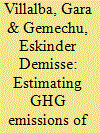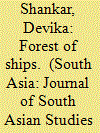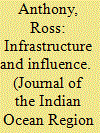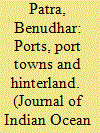|
|
|
Sort Order |
|
|
|
Items / Page
|
|
|
|
|
|
|
| Srl | Item |
| 1 |
ID:
147025


|
|
|
|
|
| Summary/Abstract |
China is the biggest foreign trade partner of ASEAN countries and the main donor to the development of regional infrastructure. The main trunk lines built with the help of Chinese investments in Southeast Asian countries will be linked up with important regional ports. This will make it possible to increase export cargo flows from the PRC to countries of ASEAN, the Middle East, and Africa.
|
|
|
|
|
|
|
|
|
|
|
|
|
|
|
|
| 2 |
ID:
103403


|
|
|
|
|
| Publication |
2011.
|
| Summary/Abstract |
In recent years, GHG inventories of cities have expanded to include extra-boundary activities that form part of the city's urban metabolism and economy. This paper centers on estimating the emissions due to seaports, in such a way that they can be included as part of the city's inventory or be used by the port itself to monitor their policy and technology improvements for mitigating climate change. We propose the indicators GHG emissions per ton of cargo handled or per passenger and emissions per value of cargo handled as practical measures for policy making and emission prevention measures to be monitored over time. Adapting existing methodologies to the Port of Barcelona, we calculated a total of 331,390 tons of GHG emissions (CO2 equivalents) for the year of 2008, half of which were attributed to vessel movement (sea-based emissions) and the other half to port, land related activities (land-based emissions). The highest polluters were auto carriers with 6 kg of GHG emissions per ton of cargo handled. Knowing the highest emitters, the port can take action to improve the ship's activities within the port limits, such as maneuvering and hotelling. With these results, the port and the city can also find ways to reduce the land-based emissions.
|
|
|
|
|
|
|
|
|
|
|
|
|
|
|
|
| 3 |
ID:
190731


|
|
|
|
|
| Summary/Abstract |
This paper examines how the annexation of Malabar by the English East India Company in the last decade of the eighteenth century allowed the colonial administration to experiment with novel forms of state control in the region’s forests. At the same time, through a focus on the connections forged between Malabar’s forests and Bombay’s dockyards, this paper will use archival sources to examine the crucial role played by the timber monopoly introduced in 1806 in dislodging Malabar and its ports from their central position in the Indian Ocean economy and facilitating their incorporation into the margins of the emerging colonial economy.
|
|
|
|
|
|
|
|
|
|
|
|
|
|
|
|
| 4 |
ID:
186950


|
|
|
|
|
| Summary/Abstract |
Will ports become less important in a post-industrial period dominated by service industries? This paper examines the impact and the spillover effects of ports on city economies. The results show that ports contribute to city economies primarily through producer and consumer services. To be specific, ports can drive the development of port-related producer services, and port spillover effects from other cities have a broader impact on producer services; the port contributes to the development of wholesale and retail trades in the local city but the boost to consumer services comes mainly from spillover effects from other ports. This paper concludes that ports are still shaping economic geography by influencing the service sector, and inter-city coordination mechanisms are suggested because of the spillover effects.
|
|
|
|
|
|
|
|
|
|
|
|
|
|
|
|
| 5 |
ID:
098619


|
|
|
|
|
| Publication |
2010.
|
| Summary/Abstract |
This study analyzes the changes in carbon dioxide (CO2) emissions resulting from the movement of containers from established ports through the emerging port of Taipei in Northern Taiwan. An activity-based emissions model is used to estimate the CO2 emissions of container transport under four scenarios where there are switches of market share from existing ports to the emerging port. The results show that there are greater reductions in CO2 when transhipment routes are changed from the ports of Kaohsiung, Taichung and Keelung to the emerging port of Taipei. The paper concludes that the analytical approach adopted in the paper can help decision-makers understand potential CO2 emissions reduction strategies in the route selection of inland container transportation and such consideration should provide a broader and more meaningful basis for the socio-economic evaluation of port investment projects.
|
|
|
|
|
|
|
|
|
|
|
|
|
|
|
|
| 6 |
ID:
125890


|
|
|
|
|
| Publication |
2013.
|
| Summary/Abstract |
This paper investigates the notion that China's proposed development of ports and supporting hinterland infrastructure on the East coast of Africa serves greater geostrategic interests within Africa and the Indian Ocean. It cautions against a trend which accuses Chinese commercial infrastructural and resource development of being symmetrical with an almost colonial-like political influence. Through a comparison with nineteenth-century German and British colonialism in the region, the paper argues that, while there are certain affinities, the Chinese presence today is significantly different. Central to the argument is that Chinese port and hinterland developments are supplemented by a host of other actors, including host states, multinational corporations and regional development funds. The broader market economic system in which China and Africa engage today entails that Chinese unfettered access to projects is complicated by the interests of multiple stakeholders. The Chinese presence has been exaggerated at the expense of other actors and thus, in any future conflict, it cannot be assumed that China will be able to mobilise this infrastructure in its interests. This has implications for the broader analysis of China's growing presence in the Indian Ocean.
|
|
|
|
|
|
|
|
|
|
|
|
|
|
|
|
| 7 |
ID:
130639


|
|
|
|
|
| Publication |
2013.
|
| Summary/Abstract |
This paper investigates the notion that China's proposed development of ports and supporting hinterland infrastructure on the East coast of Africa serves greater geostrategic interests within Africa and the Indian Ocean. It cautions against a trend which accuses Chinese commercial infrastructural and resource development of being symmetrical with an almost colonial-like political influence. Through a comparison with nineteenth-century German and British colonialism in the region, the paper argues that, while there are certain affinities, the Chinese presence today is significantly different. Central to the argument is that Chinese port and hinterland developments are supplemented by a host of other actors, including host states, multinational corporations and regional development funds. The broader market economic system in which China and Africa engage today entails that Chinese unfettered access to projects is complicated by the interests of multiple stakeholders. The Chinese presence has been exaggerated at the expense of other actors and thus, in any future conflict, it cannot be assumed that China will be able to mobilise this infrastructure in its interests. This has implications for the broader analysis of China's growing presence in the Indian Ocean.
|
|
|
|
|
|
|
|
|
|
|
|
|
|
|
|
| 8 |
ID:
115234


|
|
|
|
|
| Publication |
2012.
|
| Summary/Abstract |
The corporatisation of Port Klang from the mid-1980s onwards was a significant moment in the history of Malaysia's political economy and generated considerable momentum for the changes that were to occur in this late industrialising nation under the leadership of the Barisan Nasional government. In particular, the restructuring of how labour was organised in Malaysia's most significant port became frequently cited both within and outside the country as a model for tripartite labour privatisation and the well-managed divestment of state-owned enterprises. However, in the past decade, the organisation of labour in the port has again changed dramatically. Migrant labour from some of the poorest parts of Asia now makes up the majority of semi-skilled and unskilled workers. Based on fieldwork carried out during 2009 with workers from Bangladesh and Nepal who are employed in Port Klang, this paper suggested that a regulatory vacuum now exists in the port, which means foreign workers are often treated badly and have few avenues for dissent. An analysis of the changing labour regime in Port Klang over time can assist in understanding the contemporary political economy of Malaysia as well as illuminate debates about the spaces of migrant labour more broadly.
|
|
|
|
|
|
|
|
|
|
|
|
|
|
|
|
| 9 |
ID:
124285


|
|
|
|
|
| Publication |
2013.
|
| Summary/Abstract |
Port played an important role in the maritime history of ancient Odisha as elsewhere. The long coastline of Odisha was studded with several excellent ports and anchorages during the anceint period. Since ports of anchorage were a pre - requisite for overseas trade and commerce many ports natuarlly grew up at strategic points.
|
|
|
|
|
|
|
|
|
|
|
|
|
|
|
|
| 10 |
ID:
128120


|
|
|
|
|
| Publication |
2013.
|
| Summary/Abstract |
Palur was another important port on the coast of ancient Odisha. It occupied an enviable position on the trade-route between India and South East Asia and acted as the only port of departure to the far reference to this port appears in the work of the Greek sailor Ptolemy during the 2nd century EC who has named it as Paloura.
|
|
|
|
|
|
|
|
|
|
|
|
|
|
|
|
| 11 |
ID:
126840


|
|
|
|
|
| Publication |
2014.
|
| Summary/Abstract |
This paper's purpose is to investigate the role of sea ports in helping to mitigate the GHG emissions associated with the end-to-end maritime transport chain. The analysis is primarily focused on the UK, but is international in application. The paper is based on both the analysis of secondary data and information on actions taken by ports to reduce their emissions, with the latter data collected for the main UK ports via their published reports and/or via interviews. Only a small number of ports (representing 32% of UK port activity) actually measure and report their carbon emissions in the UK context. The emissions generated by ships calling at these ports are analysed using a method based on Department for Transport Maritime Statistics Data. In addition, a case example (Felixstowe) of emissions associated with HGV movements to and from ports is presented, and data on vessel emissions at berth are also considered.
Our analyses indicate that emissions generated by ships during their voyages between ports are of a far greater magnitude than those generated by the port activities. Thus while reducing the ports' own emissions is worthwhile, the results suggest that ports might have more impact through focusing their efforts on reducing shipping emissions.
|
|
|
|
|
|
|
|
|
|
|
|
|
|
|
|
|
|
|
|
|